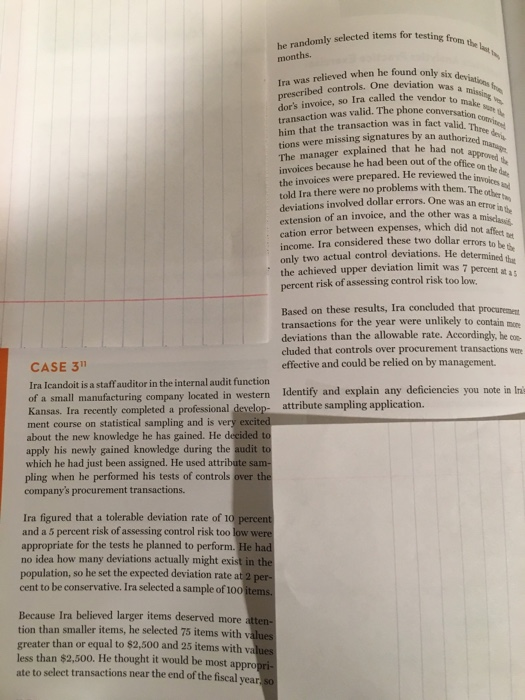he randomly selected items for testi months. Ira was relieved when he found only si prescribed controls. One deviation dor's invoice, so Ira called the vendoriss transaction was valid. The phone conversatio him that the transaction was in fact val tions were missing signatures by an authorre The manager explained that he had zd nvoices because he had been out of the ofid the invoices were prepared. He reviewed thee d told Ira there were no problems with them. Thees deviations involved dollar errors. One was an er extension of an invoice, and the other was a cation error between expenses, which did not afS income. Ira considered these two dollar errors to only two actual control deviations. He determined the achieved upper deviation limit was 7 percent percent risk of assessing control risk too low was a missing make sunt was , an autnot approved thr Based on these results, Ira concluded that transactions for the year were unlikely to contain moe deviations than the allowable rate. Accordingly, he cluded that controls over procurement transactions were effective and could be relied on by management. CASE 3" Ira Icandoit is a staff auditor in the internal audit function of a small manufacturing company western Kansas. Ira recently completed a professional develop- ment course on statistical sampling and is ver excited about the new knowledge he has gained. He decided to apply his newly gained knowledge during the audit to which he had just been assigned. He used attribute sam- pling when he performed his tests of controls over the located in western Identify and explain any deficiencies you note in Ins Identi attribute sampling application Ira figured that a tolerable deviation rate of 10 percent and a 5 percent risk of assessing control risk too low appropriate for the tests he planned to perform. He had no idea how many deviations actually might exist in the population, so he set the expected deviation rate at 2 per- cent to be conservative. Ira selected a sample of 100 items. Because Ira believed larger items deserved more atten tion than smaller items, he selected 75 items with values greater than or equal to $2,500 and 25 items with less than $2,500. He thought it would be most a ate to select transactions near the end of the fiscal year







